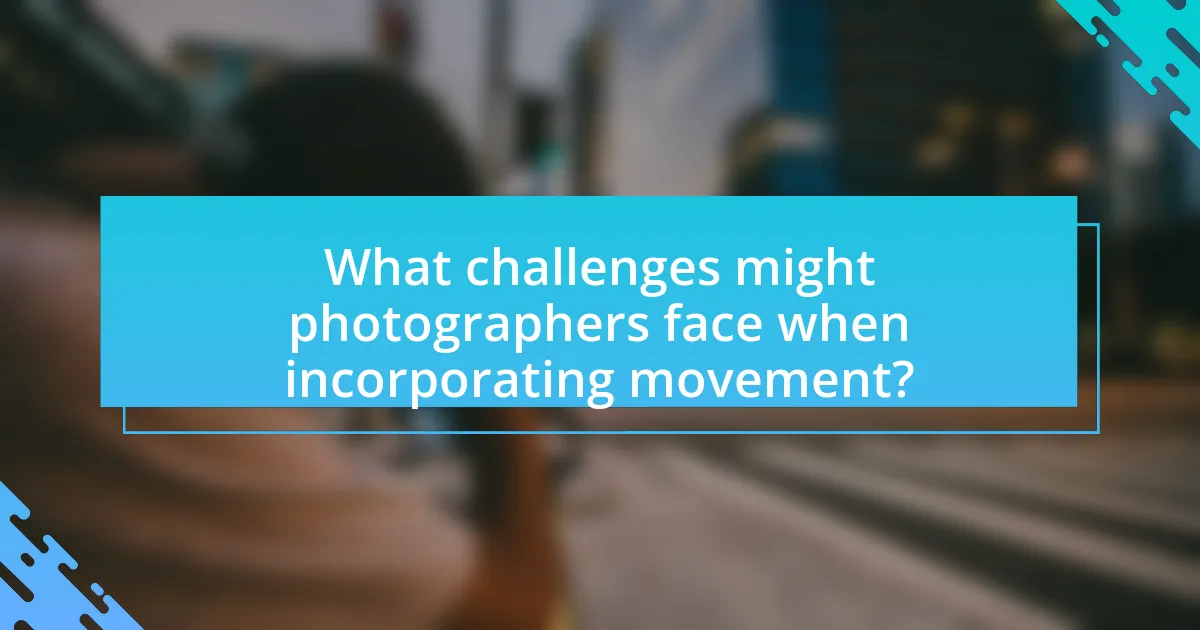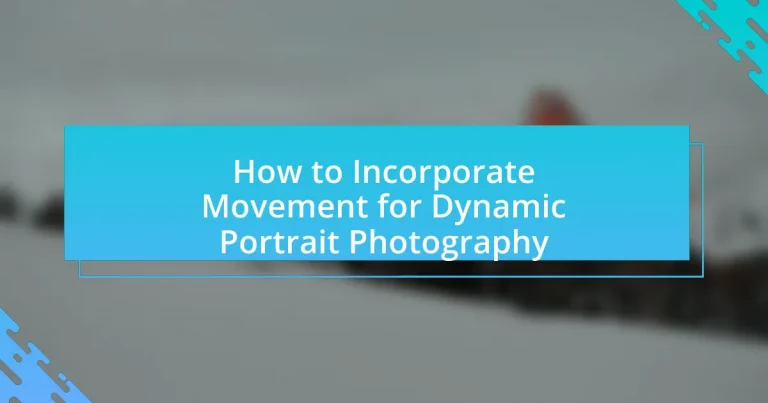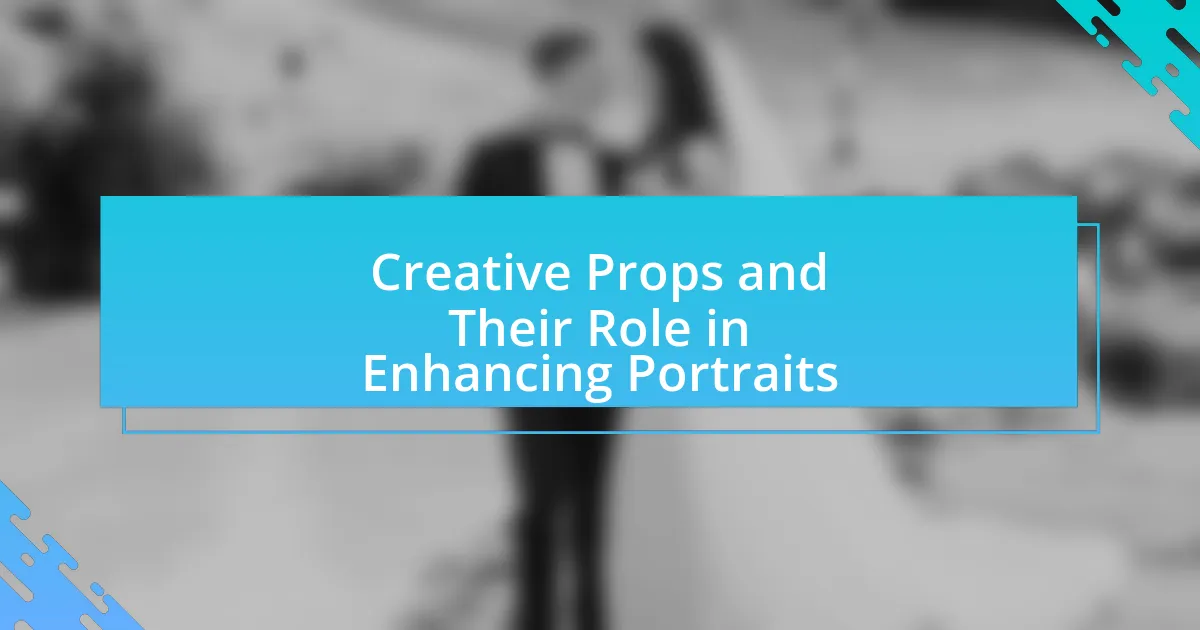Dynamic portrait photography is a technique that captures subjects in motion, enhancing the energy and emotional depth of images. This article explores how movement can be effectively incorporated into portrait photography through various techniques, such as using slow shutter speeds, dynamic poses, and environmental interactions. It discusses the advantages of movement over static poses, the emotional impact of dynamic images, and practical tips for photographers to manage challenges associated with capturing movement. Additionally, it highlights the importance of pre-shoot planning and creating a comfortable environment for subjects to facilitate authentic expressions and actions.

What is Dynamic Portrait Photography?
Dynamic portrait photography is a style that captures subjects in motion, emphasizing energy and liveliness. This approach often involves techniques such as using slower shutter speeds to create motion blur or incorporating dynamic poses and expressions to convey action. The effectiveness of dynamic portrait photography is supported by its ability to evoke emotions and tell stories, making the images more engaging and memorable.
How does movement enhance portrait photography?
Movement enhances portrait photography by adding dynamism and emotional depth to the images. When subjects are captured in motion, it creates a sense of life and energy, making the portrait more engaging. For instance, a study published in the Journal of Visual Communication and Image Representation found that images depicting movement are perceived as more lively and expressive compared to static poses. This effect can be achieved through techniques such as capturing candid moments, using longer exposure times to create motion blur, or directing subjects to interact with their environment. These methods not only convey action but also evoke feelings and narratives, enriching the viewer’s experience.
What types of movement can be incorporated into portraits?
Incorporating movement into portraits can include various types such as dynamic poses, gestures, and environmental interactions. Dynamic poses involve the subject engaging in actions like jumping, running, or dancing, which convey energy and emotion. Gestures, such as hand movements or facial expressions, can add a sense of spontaneity and life to the portrait. Environmental interactions, where the subject interacts with their surroundings—like leaning against a wall or walking through a field—can create a narrative and enhance the visual interest of the portrait. These techniques are supported by the principles of movement in photography, which emphasize capturing the essence of action to evoke feelings and tell stories.
How does movement affect the emotional impact of a portrait?
Movement enhances the emotional impact of a portrait by introducing dynamism and energy, which can evoke stronger feelings in the viewer. When a subject is captured in motion, it can convey a sense of life, spontaneity, and authenticity, making the portrait more relatable and engaging. For instance, a portrait of a dancer in mid-leap can evoke feelings of joy and freedom, while a subject caught in a moment of laughter can create a sense of warmth and connection. Research indicates that portraits featuring movement are often perceived as more expressive and emotionally resonant compared to static images, as they reflect the subject’s personality and emotional state more vividly.
Why is incorporating movement important in portrait photography?
Incorporating movement in portrait photography is important because it adds dynamism and emotional depth to the images. Movement can convey a subject’s personality, create a sense of narrative, and enhance visual interest, making the portrait more engaging for viewers. Research indicates that dynamic poses and actions can evoke stronger emotional responses, as seen in studies on viewer engagement with art, which show that images with movement are often perceived as more lively and relatable.
What advantages does movement provide over static poses?
Movement offers several advantages over static poses in dynamic portrait photography, primarily enhancing visual interest and emotional expression. By incorporating movement, photographers can capture a sense of energy and spontaneity that static poses often lack. Research indicates that images featuring movement tend to evoke stronger emotional responses from viewers, as they convey action and life, making the subject more relatable and engaging. Additionally, movement allows for a variety of angles and compositions, providing photographers with more creative options to highlight the subject’s personality and story.
How can movement convey a subject’s personality or story?
Movement can convey a subject’s personality or story by reflecting their emotional state, energy level, and individual characteristics through physical expression. For instance, a subject who moves with fluidity and grace may suggest confidence and ease, while abrupt or hesitant movements can indicate anxiety or uncertainty. Research in psychology shows that body language, including movement, plays a crucial role in nonverbal communication, with studies indicating that 55% of communication is conveyed through body language (Mehrabian, 1971). This demonstrates that the way a subject moves can significantly influence the viewer’s perception of their personality and narrative.

What techniques can be used to incorporate movement in portraits?
To incorporate movement in portraits, techniques such as using a slow shutter speed, capturing candid moments, and employing dynamic poses are effective. Slow shutter speed allows for motion blur, which can convey a sense of movement, as seen in sports photography where athletes are captured in action. Candid moments capture subjects in natural motion, creating a more dynamic and engaging portrait, as demonstrated in street photography where subjects are often unaware of the camera. Dynamic poses involve directing subjects to move or interact with their environment, enhancing the sense of liveliness in the portrait. These techniques are widely used by photographers to create visually compelling images that convey energy and action.
How can photographers effectively capture movement?
Photographers can effectively capture movement by using a fast shutter speed to freeze action or a slower shutter speed to create motion blur, depending on the desired effect. For instance, a shutter speed of 1/500th of a second or faster can freeze fast-moving subjects, while a speed of 1/30th of a second can convey a sense of motion through blur. Additionally, employing techniques such as panning—where the camera follows the moving subject—can enhance the feeling of speed while keeping the subject sharp against a blurred background. These methods are supported by the principles of photography that emphasize the relationship between shutter speed and motion, allowing photographers to choose the best approach based on the scene and subject dynamics.
What camera settings are optimal for photographing movement?
Optimal camera settings for photographing movement include a fast shutter speed, typically 1/500 seconds or faster, to freeze action. Additionally, using a wide aperture, such as f/2.8 or lower, allows for a shallow depth of field, which isolates the subject from the background. Setting a high ISO, around 800 or higher, can help in low-light conditions while maintaining a fast shutter speed. These settings are effective because they minimize motion blur and enhance subject clarity, crucial for capturing dynamic portraits.
How can lighting be adjusted to enhance movement in portraits?
Lighting can be adjusted to enhance movement in portraits by using directional light sources and varying intensity to create dynamic shadows and highlights. Directional lighting, such as side lighting or backlighting, emphasizes the contours of the subject’s body, making movement more pronounced. Additionally, using a faster shutter speed in conjunction with controlled lighting can freeze motion effectively, while softer lighting can create a sense of fluidity. Studies in photography demonstrate that the interplay of light and shadow can significantly influence the perception of movement, as seen in works by renowned photographers like Henri Cartier-Bresson, who utilized natural light to capture dynamic scenes.
What are some creative ways to direct movement in portrait sessions?
To direct movement creatively in portrait sessions, photographers can use techniques such as prompting subjects to engage in specific actions, incorporating props, and utilizing the environment. For instance, asking subjects to walk towards the camera or spin can create dynamic poses. Props like scarves or balloons can add visual interest and encourage movement. Additionally, leveraging natural elements, such as wind or water, can enhance the sense of motion. These methods not only result in more engaging images but also help subjects feel more relaxed and natural, leading to authentic expressions.
How can props be used to encourage movement in portraits?
Props can be used to encourage movement in portraits by providing subjects with tangible elements to interact with, which naturally leads to dynamic poses. For instance, using flowing fabrics, such as scarves or skirts, can create a sense of motion as they catch the wind or are manipulated by the subject. Additionally, incorporating items like balloons or musical instruments can prompt subjects to engage in actions, such as tossing or playing, which results in more animated expressions and body language. Studies in visual arts emphasize that movement in photography enhances emotional engagement, making portraits more compelling and lively.
What role does music play in facilitating movement during a shoot?
Music plays a crucial role in facilitating movement during a shoot by creating an engaging atmosphere that encourages spontaneity and fluidity in poses. The rhythm and tempo of music can influence the energy levels of the subjects, prompting them to move more naturally and expressively. Studies have shown that music can enhance mood and reduce anxiety, which allows subjects to feel more comfortable and free to explore various movements. For instance, a study published in the Journal of Experimental Psychology found that participants exposed to upbeat music exhibited increased physical activity and creativity in their movements. This connection between music and movement is essential for dynamic portrait photography, as it helps capture authentic expressions and actions.

What challenges might photographers face when incorporating movement?
Photographers face several challenges when incorporating movement, primarily related to capturing sharp images, managing lighting conditions, and directing subjects. The difficulty in achieving sharpness arises because movement can lead to motion blur, making it essential for photographers to use faster shutter speeds or stabilization techniques. Additionally, varying lighting conditions can complicate exposure settings, as movement may require adjustments to maintain proper illumination without losing detail. Furthermore, directing subjects to achieve natural movement while maintaining compositional integrity can be challenging, as it requires effective communication and timing to capture the desired dynamic effect.
How can photographers overcome common obstacles in dynamic portrait photography?
Photographers can overcome common obstacles in dynamic portrait photography by utilizing techniques such as pre-visualization, effective communication with subjects, and mastering camera settings. Pre-visualization allows photographers to anticipate movement and plan compositions accordingly, which is crucial for capturing dynamic moments. Effective communication ensures that subjects understand the desired actions, leading to more natural and engaging poses. Mastering camera settings, particularly shutter speed and focus, enables photographers to freeze motion or create intentional blur, enhancing the dynamic quality of the portraits. These strategies collectively address challenges like timing, subject engagement, and technical execution, leading to successful dynamic portrait photography.
What techniques can help manage motion blur effectively?
To manage motion blur effectively, photographers can utilize techniques such as adjusting shutter speed, using image stabilization, and employing panning methods. Adjusting shutter speed allows for faster capture of movement, reducing the likelihood of blur; for instance, a shutter speed of 1/500th of a second can freeze action. Image stabilization, whether through lens technology or camera settings, compensates for small movements, enhancing clarity. Panning involves moving the camera in sync with a moving subject, which can create a sense of motion while keeping the subject sharp, as demonstrated in sports photography where this technique is commonly applied.
How can photographers ensure they capture the right moment amidst movement?
Photographers can ensure they capture the right moment amidst movement by using fast shutter speeds and continuous shooting modes. Fast shutter speeds, typically 1/500 seconds or faster, freeze motion, allowing photographers to capture sharp images of moving subjects. Continuous shooting modes enable photographers to take multiple frames per second, increasing the likelihood of capturing the perfect moment. Research indicates that using these techniques significantly improves the chances of obtaining clear, dynamic shots in fast-paced environments, as evidenced by studies in sports photography where timing is crucial for capturing key actions.
What are the best practices for successful dynamic portrait photography?
The best practices for successful dynamic portrait photography include using fast shutter speeds, incorporating movement in the subject, and utilizing natural light effectively. Fast shutter speeds, typically 1/500 second or faster, freeze motion and prevent blur, ensuring clarity in dynamic shots. Incorporating movement, such as having the subject walk, jump, or interact with their environment, adds energy and life to the portrait. Utilizing natural light, especially during golden hour, enhances the subject’s features and creates a warm, inviting atmosphere. These practices are supported by the fact that dynamic portraits often engage viewers more effectively, as evidenced by studies showing that images with movement evoke stronger emotional responses.
How can pre-shoot planning enhance the incorporation of movement?
Pre-shoot planning enhances the incorporation of movement by allowing photographers to visualize and strategize the dynamic elements of a shoot in advance. This preparation includes determining the desired types of movement, selecting appropriate locations, and coordinating with subjects to create a fluid shooting environment. For instance, planning can involve choreographing specific actions or poses that convey energy, which can lead to more engaging and lively portraits. Additionally, by scouting locations and considering lighting conditions beforehand, photographers can optimize the use of natural movement, such as wind or the subject’s interaction with their surroundings, resulting in more authentic and dynamic imagery.
What tips can help photographers maintain a comfortable environment for subjects during movement?
To maintain a comfortable environment for subjects during movement, photographers should communicate clearly and establish a relaxed atmosphere. Clear communication helps subjects understand what to expect, reducing anxiety and fostering confidence. Creating a relaxed atmosphere can be achieved by using a friendly tone, encouraging natural movement, and providing positive feedback throughout the session. Studies show that subjects who feel comfortable are more likely to express genuine emotions, resulting in more dynamic and engaging portraits.

















